1997 GMC SIERRA air condition
[x] Cancel search: air conditionPage 357 of 436
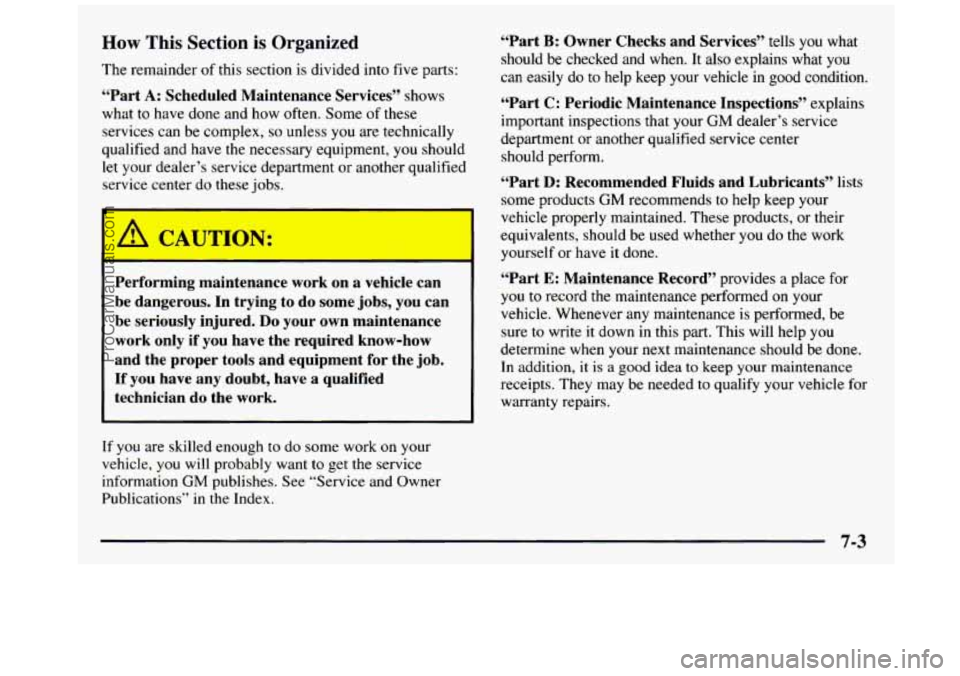
How This Section is Organized
The remainder of this section is divided into five parts:
“Part
A: Scheduled Maintenance Services” shows
what to have done and how often. Some of these
services can be complex,
so unless you are technically
qualified and have the necessary equipment, you should
let your dealer’s service department or another qualified
service center do these jobs.
Performing maintenance work on a vehicle can
be dangerous. In trying to do some jobs, you can
be seriously injured.
Do your own maintenance
work only if you have the required know-how
and the proper
tools and equipment for the job.
If you have any doubt, have a qualified
technician do the work.
If you are skilled enough to do some work on your
vehicle, you will probably want to get the service
information GM publishes. See “Service and Owner
Publications”
in the Index. “Part
B: Owner Checks and
Services” tells you what
should be checked and when. It also explains what you
can easily do to help keep your vehicle in good condition.
“Part
C: Periodic Maintenance Inspections” explains
important inspections that your GM dealer’s service
department or another qualified service center
should perform.
“Part
D: Recommended Fluids and Lubricants” lists
some products GM recommends to help keep your
vehicle properly maintained. These products, or their
equivalents, should be used whether you do the work
yourself or have it done.
“Part
E: Maintenance Record” provides a place for
you to record the maintenance performed on your
vehicle. Whenever any maintenance
is performed, be
sure
to write it down in this part. This will help you
determine when your next maintenance should be done.
In addition, it is a good idea to keep your maintenance
receipts. They may be needed to qualify your vehicle for
warranty repairs.
ProCarManuals.com
Page 358 of 436

Part A: Scheduled Maintenance
Services
Using Your Maintenance Schedule
We at General Motors want to help you keep your vehicle
in good working condition. But we don’t know exactly
how you’ll drive it.
You may drive very short distances
only
a few times a week. Or you may drive long distances
all the time in
very hot, dusty weather. You may use your
vehicle
in making deliveries. Or you may drive it to work,
to do errands or
in many other ways.
Because of all the different ways people use their GM
vehicles, maintenance needs vary. You may even need
more frequent checks and replacements than you’ll find
in
the schedules in this section. So please read this
section and note how you drive. If you have any
questions
on how to keep your vehicle in good
condition, see your GM dealer.
This part tells you the maintenance services you should
have done and when you should schedule them. If you
go to your dealer for your service needs, you’ll know
that GM-trained and supported service people will
perform the work using genuine
GM parts.
The proper fluids
and lubricants to use are listed in Part D.
Make sure whoever services your vehicle uses these. All parts should
be replaced and all necessary repairs done
before you
or anyone else drives the vehicle.
These schedules are for vehicles that:
0
0
0
0
carry passengers and cargo within recommended
limits. You will find these limits on your vehicle’s
Certificatioflire label. See “Loading Your Vehicle”
in the Index.
are driven
on reasonable road surfaces within legal
driving limits.
are driven off-road in the recommended manner. See
“Off-Road Driving With Your Four-Wheel-Drive
Vehicle’’
in the Index.
use the recommended fuel. See “Fuel”
in the Index.
Selecting the Right Schedule
First you’ll need to decide which of the two schedules is
right for your vehicle. Here’s how to decide which
schedule to follow:
Gasoline engine vehicles and diesel engine vehicles
have different maintenance requirements. If you have a
diesel engine, follow
a schedule designated for diesel
engine vehicles only.
See the Diesel Engine Supplement for diesel engine
maintenance schedules.
7-4
ProCarManuals.com
Page 400 of 436
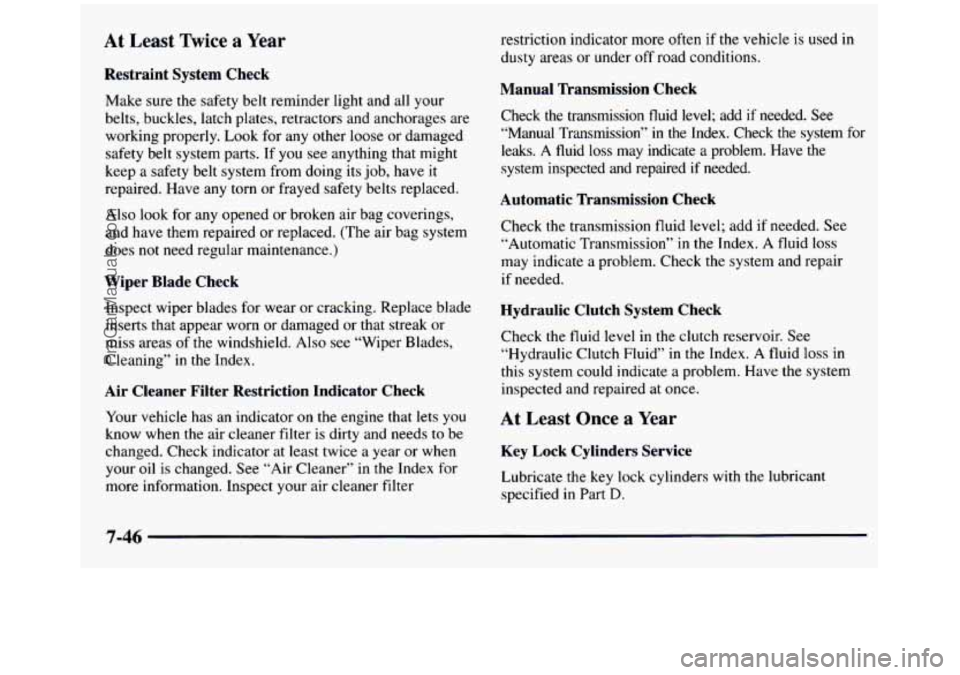
At Least Twice a Year
Restraint System Check
Make sure the safety belt reminder light and all your
belts, buckles,
latch plates, retractors and anchorages are
working properly. Look for any other loose or damaged
safety belt system
parts. If you see anything that might
keep a safety belt system from doing its job, have it
repaired. Have any torn or frayed safety belts replaced.
Also look for any opened or broken air bag coverings,
and have them repaired or replaced. (The air bag system
does
not need regular maintenance.)
Wiper Blade Check
Inspect wiper blades for wear or cracking. Replace blade
inserts that appear worn or damaged or that streak or
miss areas of the windshield. Also see “Wiper Blades,
Cleaning” in the Index.
Air Cleaner Filter Restriction Indicator Check
Your vehicle has an indicator on the engine that lets you
know when the air cleaner filter is dirty and needs
to be
changed. Check indicator at least twice a year or when
your oil is changed. See “Air Cleaner” in
the Index for
more information. Inspect your air cleaner filter restriction indicator more often
if the vehicle is used in
dusty areas or under off road conditions.
Manual Transmission Check
Check the transmission fluid level; add if needed. See
“Manual Transmission” in
the Index. Check the system for
leaks. A fluid loss may indicate a problem. Have the
system inspected and repaired if needed.
Automatic Transmission Check
Check the transmission fluid level; add if needed. See
“Automatic Transmission” in the Index.
A fluid loss
may indicate a problem. Check the system and repair
if needed.
Hydraulic Clutch System Check
Check the fluid level in the clutch reservoir. See
“Hydraulic Clutch Fluid” in the Index. A fluid loss in
this system could indicate a problem. Have the system
inspected and repaired
at once.
At Least Once a Year
Key Lock Cylinders Service
Lubricate the key lock cylinders with the lubricant
specified
in Part D.
7-46
ProCarManuals.com
Page 403 of 436
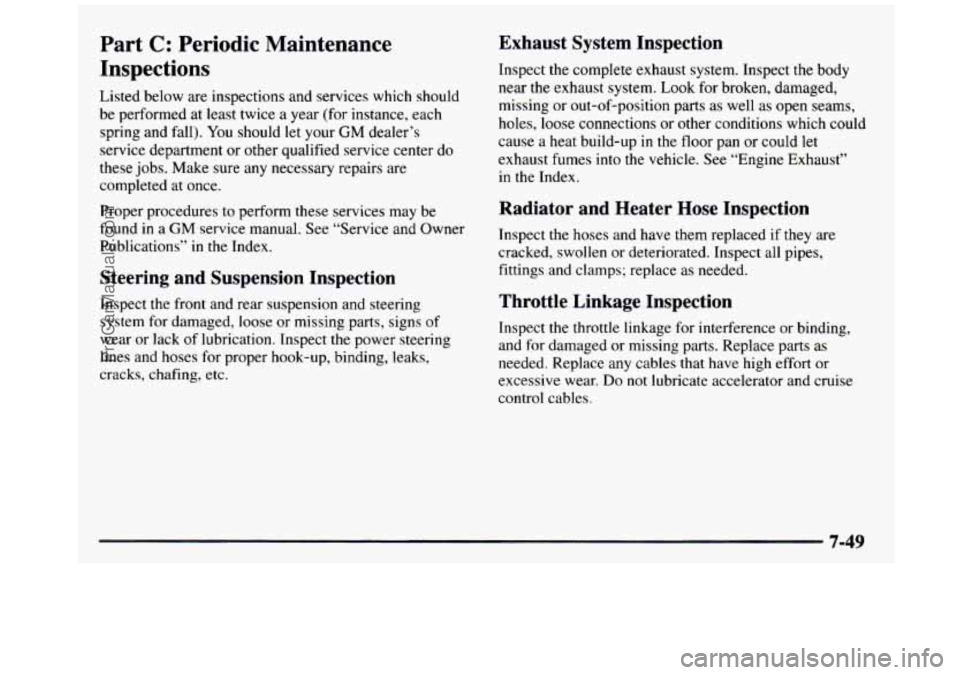
Part C: Periodic Maintenance
Inspections
Listed below are inspections and services which should
be performed at least twice a year (for instance, each
spring and fall). You should let your GM dealer’s
service department or other qualified service center do
these jobs. Make sure any necessary repairs are
completed at once.
Proper procedures to perform these services may be
found
in a GM service manual. See “Service and Owner
Publications’’
in the Index.
Steering and Suspension Inspection
Inspect the front and rear suspension and steering
system for damaged, loose or missing parts, signs of
wear or lack of lubrication. Inspect the power steering
lines
and hoses for proper hook-up, binding, leaks,
cracks, chafing, etc.
Exhaust System Inspection
Inspect the complete exhaust system. Inspect the body
near the exhaust system.
Look for broken, damaged,
missing or out-of-position parts as well as open seams,
holes, loose connections or other conditions which could
cause
a heat build-up in the floor pan or could let
exhaust fumes into the vehicle. See “Engine Exhaust”
in the Index.
Radiator and Heater Hose Inspection
Inspect the hoses and have them replaced if they are
cracked, swollen or deteriorated. Inspect all pipes,
fittings and clamps; replace as needed.
Throttle Linkage Inspection
Inspect the throttle linkage for interference or binding,
and for damaged or missing parts. Replace parts as
needed. Replace any cables that have high effort
or
excessive wear. Do not lubricate accelerator and cruise
control cables.
ProCarManuals.com
Page 423 of 436
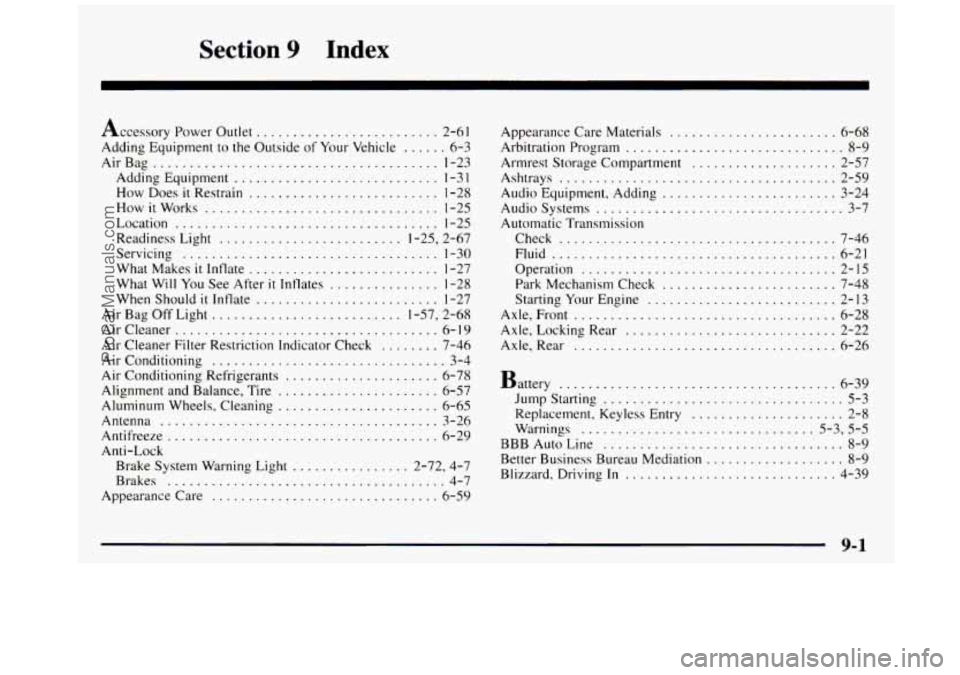
Section 9 Index
Accessory Power Outlet ......................... 2-6 I
Adding Equipment to the Outside of Your Vehicle ...... 6-3
AirBag ....................................... 1-23
Adding Equipment ............................ 1-3 1
How Does it Restrain .......................... 1-28
How
it Works ................................ 1-25
Location
.................................... 1-25
Readiness Light
......................... 1-25. 2-67
Servicing
................................... 1-30
What Makes it Inflate .......................... 1-27
What Will You See After
it Inflates ............... 1-28
When Should
it Inflate ......................... 1-27
Air Bag Off Light
.......................... 1-57, 2-68
Aircleaner
.................................... 6-10
Air Cleaner Filter Restriction Indicator Check ........ 7-46
Air Conditioning
................................ 3-4
Air Conditioning Refrigerants ..................... 6-78
Alignment and Balance. Tire
...................... 6-57
Aluminum Wheels. Cleaning
...................... 6-65
Antenna
...................................... 3-26
Antifreeze
..................................... 6-29
Anti-Lock Brake System Warning Light
................ 2-72. 4.7
Brakes
...................................... 4-7
Appearance Care
............................... 6-59 Appearance Care
Materials
....................... 6-68
Arbitration Program .............................. 8-9
Armrest Storage Compartment
.................... 2-57
Ashtrays
...................................... 2-59
Audio Equipment. Adding
........................ 3-24
Audio Systems
.................................. 3-7
Automatic Transmission
Check
...................................... 7-46
Fluid
....................................... 6-21
Operation
................................... 2-15
Park Mechanism Check
........................ 7-48
Starting Your Engine
.......................... 2-13
Axle.
Front .................................... 6-28
Axle. Locking Rear
............................. 2-22
Axle. Rear
.................................... 6-26
Battery ...................................... 6-39
Jump Starting ................................. 5-3
Replacement. Keyless Entry
..................... 2-8
Warnings
................................ 5.3. 5.5
BBB Auto Line ................................. 8-9
Better Business Bureau Mediation ................... 8-9
Blizzard. Driving In ............................. 4-39
9-1
ProCarManuals.com
Page 430 of 436
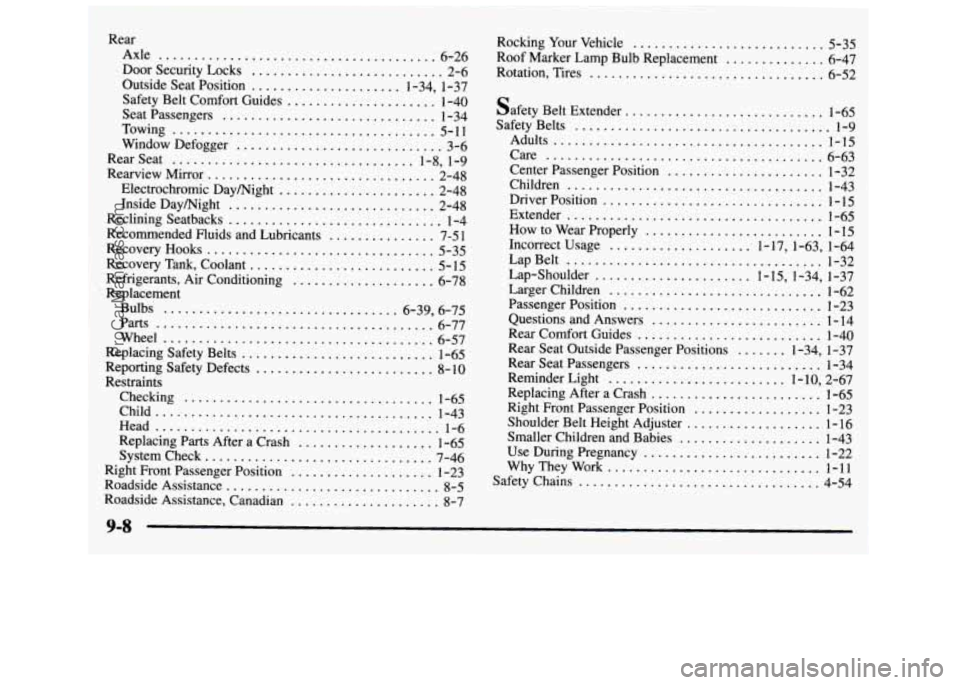
Rear Axle
......................................-'6-26
DoorSecurityLocks ........................... 2-6
Outside Seat Position ..................... 1-34, 1-37
Safety Belt Comfort Guides
..................... 1-40
Window Defogger
............................. 3-6
Electrochromic Daymight ...................... 2-48
Inside Daymight
............................. 2-48
Reclining Seatbacks
.............................. 1-4
Recommended Fluids and Lubricants
............... 7-5 1
Recovery Tank, Coolant
.......................... 5- 15
Refrigerants. Air Conditioning
.................... 6-78
Seatpassengers
,............................. l-34
Towing ..................................... 5-11
RearSeat
.................................. 1-8, 1-9
Rearview Mirror 2-48
................................
RecoveryHooks ................................ 5-35
Replacement
Bulbs
................................. 6-39, 6-75
Parts
....................................... 6-77
Wheel
...................................... 6-57
Replacing Safety Belts ........................... 1-65
Reporting Safety Defects
......................... 8- 10
Restraints Checking
................................... l-65
Head ........................................ l-6
7-46
Child
....................................... 1-43
Replacing Parts After
a Crash ................... 1-65
Right Front Passenger Position
.................... 1-23
Roadside Assistance .............................. 8-5
Roadside Assistance. Canadian ..................... 8-7
System Check
................................
Rocking
Your Vehicle ........................... 5-35
Roof Marker Lamp Bulb Replacement .............. 6-47
Rotation. Tires
................................. 6-52
safety Belt Extender ............................ 14-55
Center Passenger Position
...................... 1-32
How
to Wear Properly ......................... 1-15
Incorrect Usage
.................... 1-17? 1-63, 1-64
Lap-Shoulder
...................... 1-15. 1-34. 1-37
Passenger Position
............................ 1-23 Questions and Answers ........................ 1-14
Rear Comfort Guides
.......................... 1-40
Rear Seat Outside Passenger Positions
....... 1-34. 1-37
Rear Seat Passengers
.......................... 1-34
Reminder Light
.......................... 1-10, 2-67
Replacing After
a Crash ........................ 1-65
Right Front Passenger Position
.................. 1-23
Shoulder Belt Height Adjuster
................... 1-16
Smaller Children and Babies
.................... 1-43
Use During Pregnancy ......................... 1-22
Why They Work .............................. 1-11
Safety Belts .................................... 1-9
Adults
.........,............................ l-15
Care 6-63
Children .................................... 1-43
Driver Position ............................... 1-15
Extender
.................................... 1-65
.......................................
.................................... Lap Belt 1-32
Larger Children
.............................. 1-62
Safety Chains
.................................. 4-54
9-8
ProCarManuals.com